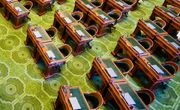This new, weekly feature from CSBA will highlight a new education law signed by the Governor in 2018. All laws are effective Jan. 1, 2019, unless otherwise noted. The full What’s New for 2019 report on all new laws affecting K-12 education is available at www.csba.org/whatsnewfor2019.
AB 2657, pupil restraint and seclusion
Assembly Bill 2657 (Weber, D-San Diego) states that school staff are not permitted to physically restrain or isolate students as a form of discipline, and may use restraint or seclusion only if a student’s behavior poses an immediate threat of physical harm.
While many local educational agencies currently follow this or a similar protocol, Education Code did not (prior to the signing of this bill) specifically delineate when or how LEAs were permitted to use restraint and seclusion practices.
Prior legislation, commonly referred to as the “Hughes Bill” (AB 2586, Chapter 959, Statutes of 1990) addressed these and other behavioral interventions for special education students, but those provisions have been amended by various subsequent legislation and other policy changes.
AB 2657 codifies protocol for restraint and seclusion, and applies it to all students.
Specifically, the bill states an educational provider may not do any of the following:
- Use seclusion or a behavioral restraint for the purpose of coercion, discipline, convenience, or retaliation.
- Use locked seclusion, unless it is in a facility otherwise licensed or permitted by state law to use a locked room.
- Use a physical restraint technique that obstructs a pupil’s respiratory airway or impairs the pupil’s breathing or respiratory capacity, including techniques in which a staff member places pressure on a pupil’s back or places his or her body weight against the pupil’s torso or back.
- Use a behavioral restraint technique that restricts breathing, including, but not limited to, using a pillow, blanket, carpet, mat, or other item to cover a pupil’s face.
- Place a pupil in a facedown position with the pupil’s hands held or restrained behind the pupil’s back.
- Use a behavioral restraint for longer than is necessary to contain the behavior that poses a clear and present danger of serious physical harm to the pupil or others.
AB 2657 also specifies, among other provisions, that pupils in seclusion must be constantly and directly supervised by staff through a window or other barrier that allows for direct eye contact with the pupil (indirect methods such as closed-circuit cameras are not allowed), and that, if a face-down (or “prone”) restraint is used, the pupil must be monitored for signs of physical distress – where possible, this monitoring must be done by staff who were not involved in the restraint.





